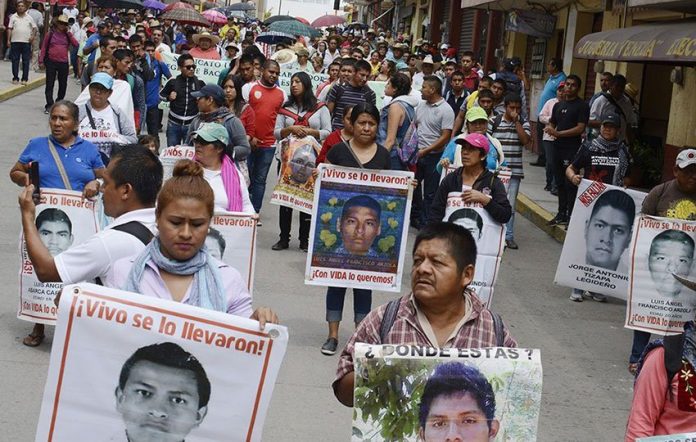A judge has cast doubt on the federal government’s “historical truth” regarding the 2014 disappearance of 43 students in Guerrero by ruling that statements on which the findings were based were obtained illegally and must be dismissed.
Martha Georgina Comte Villalobos, a federal court judge in Matamoros, Tamaulipas, said the 83 statements made by the majority of people accused of involvement in the crime must be omitted from the Ayotzinapa investigation due to evidence that their human rights were violated.
Guerrero state police, agents from the federal Attorney General’s office (PGR), Federal Police and army and navy personnel, “among others,” committed the abuses, the judge declared.
In a resolution issued on October 25, Comte said that most of the people accused of playing a role in the disappearance and presumed death of the students were subjected to “torture [and] cruel, inhumane and degrading treatment,” “illegal arrest” or unlawful “prolonged detention.”
Some of those detained were subjected to all three violations of their human rights, the judge said.
Statements made by three men identified as being actual perpetrators of the crime – Agustín “El Chereje” García Reyes, Jonathan “El Jona” Osorio Cortés and Patricio “El Pato” Reyes Landa – were among those dismissed by the judge.
The three men, all of whom supported the federal government’s official version of events, were released from custody.
“The majority of the witnesses whose fundamental rights were violated . . . ended up accepting the deeds attributed to them and those who didn’t formulated accusations against various people . . . It’s not explicable that practically all of them, despite having the right to not give evidence and to not self-incriminate, ended up doing so . . .” the judge’s resolution said.
According to the government’s “historical truth,” the 43 students from the Ayotzinapa rural teachers’ college were intercepted by corrupt municipal police in Iguala, Guerrero, in September 2014 while traveling on buses they had commandeered to travel to a protest march in Mexico City.
The police then handed them over to members of the Guerreros Unidos gang who killed the students, burned their bodies in a municipal dump and scattered their ashes in a local river.
Former Attorney General Jesús Murillo Karam told a press conference in January 2015 that the version of events he described was “a legal certainty.”
However, the government’s conclusion has been widely questioned both within Mexico and internationally and authorities have been heavily criticized for their handling of the case.
Many suspect that the army may have played a role in the disappearance and presumed murder of the students.
The United Nations (UN) said in a report published in March that 34 people were tortured in connection with the investigation.
The report, entitled Double Injustice: Human Rights Violations in the Investigation of the Ayotzinapa Case, said that “there are solid grounds to believe that torture” including “beatings, kicks, electric shocks, blindfolding, attempted asphyxia, sexual assault and various forms of psychological torture” was committed against 33 men and one woman who were arrested in relation to the case.
Torture mainly occurred in the first 48 hours after arrest, and some cases occurred at the offices of the Special Prosecutor for the Investigation of Organized Crime (SEIDO), a division of the PGR, the report said.
Judge Comte corroborated that finding, stating in her resolution that there are medical opinions that “confirm the deterioration” of the physical condition of many of the accused while held in SEIDO custody.
Medical examinations found that the three recently released men – García, Osorio and Reyes – had all sustained injuries but, according to authorities, they occurred before they were arrested.
A doctor who assessed García said that he was injured while working at home but the judge declared that the claim was “absurd,” pointing out that a naval medical report stated that he was in good health at the time of his arrest.
According to the PGR, the two other men, who were allegedly drunk at the time of their arrest, suffered injuries after falling while trying to evade capture.
But Comte questioned why the three men would have “spontaneously declared” to belonging to the Guerreros Unidos gang and killing the students if they were not under duress.
There are no “reasonable explanations” for the men’s “spontaneous confessions about very serious events,” she said.
The disappearance of the 43 students is considered the biggest of several blemishes on the record of President Peña Nieto.
However, the president said in August that he stood by the “historical truth” declared by investigators, a stance that was quickly criticized by the Centro Prodh human rights group.
It said that the federal government continues to insist on maintaining its “historical lie.”
President-elect López Obrador met with parents of the missing students on September 26 – the fourth anniversary of their disappearance – and vowed to discover the truth about what happened to them.
In June, a federal court ordered the creation of a truth and justice commission to undertake a new investigation into the case, declaring that the initial one was not “was not prompt, effective, independent or impartial on the part of the PGR.”
However, the federal government has not acted on the court’s directive.
López Obrador said that if the commission has not been created by December 1 – the date he will be sworn in as president – he will create it by decree.
Source: Milenio (sp)
